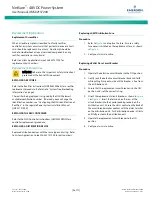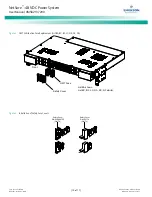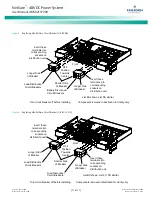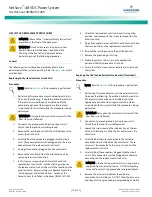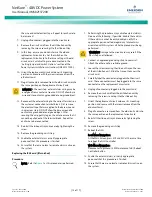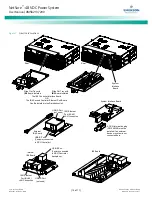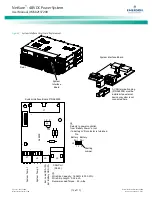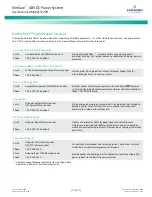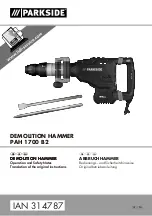
NetSure
™
-48 VDC Power System
User Manual, UM582137200
Spec. No: 582137200
Document Code: UM582137200
Model No: NetSure™ 5100
Revision A, January 11, 2017
[8 of 17]
Troubleshooting and Repair
Contact Information
Support contact information is provided at the back of this
document.
Controller and Rectifier
For troubleshooting and repair instructions on these units, refer to
the following documents.
•
NCU Controller Instructions (UM1M830BNA)
•
Rectifier Instructions (UM1R482000e3)
Controller Configuration
If any controller configuration settings were changed, refer to the
NCU Controller Instructions (UM1M830BNA) and save a copy of
the configuration file. This file can be used to restore the
controller settings, if required, at a later date.
NOTE: Provided on a USB drive furnished with the system
is a Controller Configuration Drawing (C-drawing) and
the controller configuration files loaded into the
controller as shipped.
System Troubleshooting Information
This system is designed for ease in troubleshooting and repair. The
various indicators as described in “Local Controls and Indicators”
on page 2 and in the controller and rectifier instructions are
designed to isolate failure to a specific element. Once the faulty
element has been identified, refer to “Replacement Information”
on page 9 and “Replacement Procedures” on page 9.
Troubleshooting Alarm Conditions on the Controller
The controller displays alarm conditions as listed in the “Resolving
Alarms” section of the controller’s User Manual. Programmable
external alarm relays are also available. Refer to the System
Installation Instructions (IM582137200) and the Controller
Configuration Drawing (C-drawing) supplied with your power
system documentation for your alarm relay configurations.
The controller’s
Active Alarm
and
Alarm History
submenus allow the
User to view alarm details. Refer to the NCU Controller
Instructions (UM1M830BNA) to access these menus.
Checking the Controller’s Current Limit Point after Adding or
Removing a Rectifier
If a rectifier module is added; the respective current limit point in
amps will automatically increase to maintain the same percentage.
For example, if the current limit was set to 100% of combined
capacity and a rectifier module is added, the new current limit
setpoint will be 100% of the combined capacity including the new
rectifier module.
If a rectifier module is removed from the system (and the Rect
Comm Fail is cleared), the current limit point will remain
unchanged unless the capacity of the remaining rectifiers is not
sufficient to maintain this current limit point. If that happens, the
current limit point will automatically decrease to the maximum
(121% of the remaining rectifiers).
It is recommended that the current limit point be checked
whenever a rectifier is added to or removed from the power
system.
When setting total rectifier current limit, the set point to each
rectifier is the total set point divided by the number of rectifiers.
For example, if the system contains five rectifiers and the current
limit is set to 150 amps then each rectifier has a current limit set
point of 30 amps. If one or more rectifiers are removed or fails it
will take several seconds for the individual set points to the
remaining rectifiers to be reset. In the example given, if one
rectifier is removed the current limit set point will drop to 120
amps (30 amps times four remaining rectifiers) until the controller
can send updated set points to the remaining rectifiers. This takes
a couple communication cycles (several seconds) after which each
rectifier would have a new set point of 37.5 amps for a total of 150
amps. The total current limit of the rectifiers should not be set
such that the loss of the redundant rectifiers will cause this
temporary set point to drop below the actual maximum expected
load. If batteries are used on the rectifier output, the batteries
should support the load until the current limit set points can be re-
established due to loss of a rectifier.
Refer to the NCU Controller Instructions (UM1M830BNA) for a
procedure.
Clearing a Rectifier Communications Fail Alarm after Removing
a Rectifier
If a rectifier module is removed from the system, a rectifier
communications failure alarm is generated. If the rectifier module
will not be replaced, the alarm should be cleared.
Refer to the NCU Controller Instructions (UM1M830BNA) for a
procedure.
Clearing a Rectifier Lost Alarm
If the controller resets while a rectifier communications fail alarm is
active, the rectifier communications fail alarm is replaced with a
rectifier lost alarm.
Refer to the NCU Controller Instructions (UM1M830BNA) for a
procedure to clear the alarm.
















